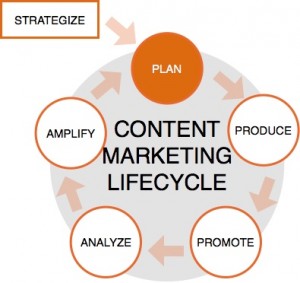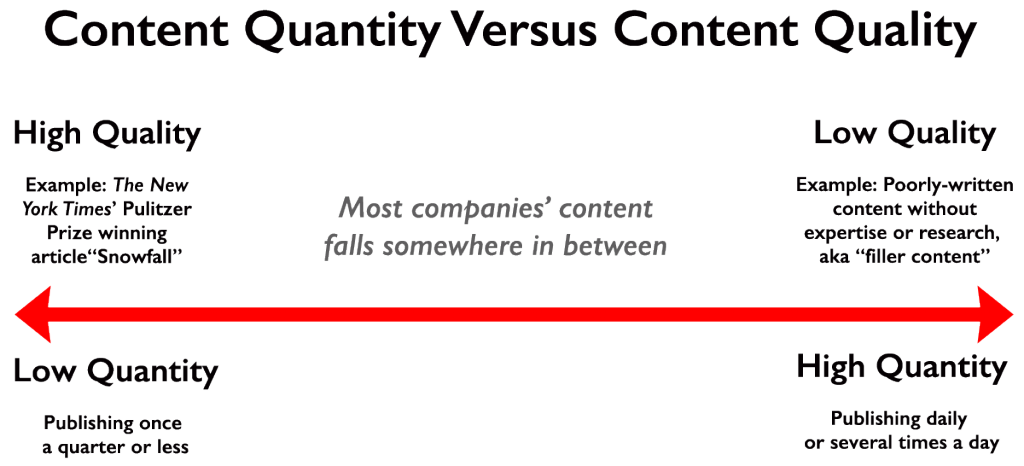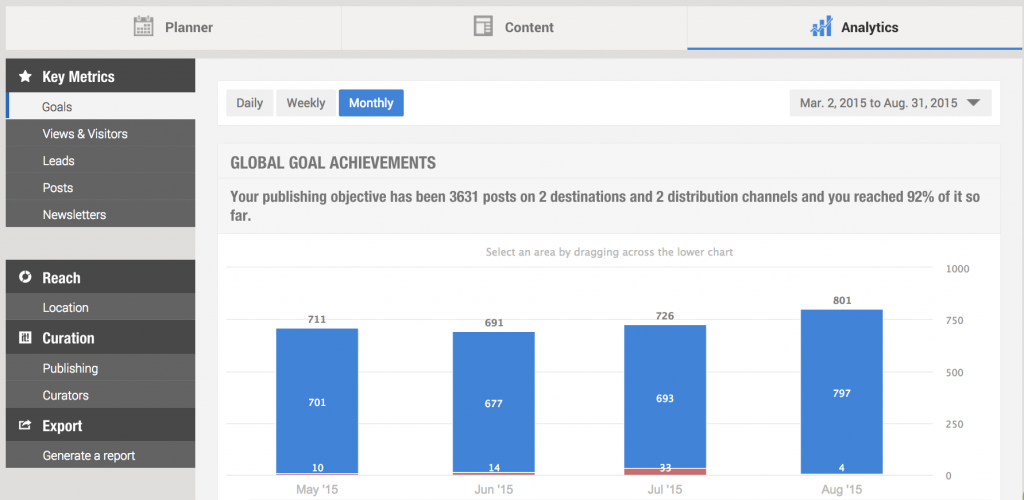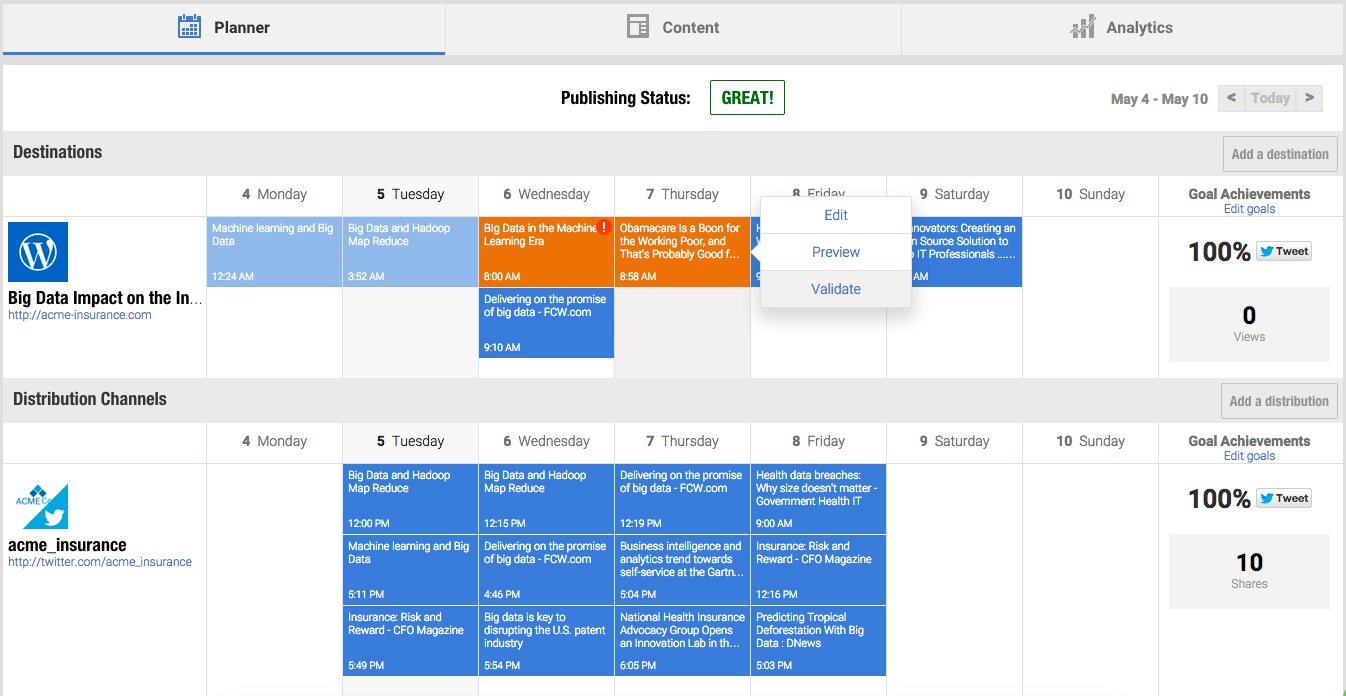
We’ve said it before and we’ll say it again: content marketing is an ongoing cycle that requires optimization at every phase in order to be successful. Effective content marketing is about managing the entire content marketing lifecycle– strategizing, planning, producing, promoting, analyzing and amplifying, and repeating. But if you’re just getting started with content marketing, it’s easy to over-focus on your own lack of content and jump straight to solving the production problem, without first laying the essential groundwork of having a proper strategy or plan in place. Neglecting just one of the phases of the content marketing lifecycle means setting yourself up for failure.
Quick recap: The last series in this six-part installment on how to optimize the content marketing lifecycle for success focused on the first phase of the content marketing lifecycle: how to strategize your content marketing. Here, you learned about establishing goals, identifying audience personas, answering frequently asked questions, and mapping the funnel your content to the different stages of the customer journey.
Now that you’re a content strategy expert, it’s time to move on to the next phase of the content marketing lifecycle: planning.

Why it matters to plan ahead
Most content marketing efforts fail due to a lack of proper planning. Creating content just for content’s sake is not content marketing, nor is it effective. All too often marketers rush into content production without taking the time to research and plan in advance. While creating good content is certainly important, it’s not enough to succeed on its own without having first established a clear directional path for your content to follow that aligns with your business goals and objectives. Content without structure or organization falls short of achieving the goals it was intended to reach.
Establishing a plan for your content marketing strategy is a critical component for guiding your content creation efforts and keeping them focused on your business goals and objectives. While creating good content is certainly a piece of the overall content marketing puzzle, it’s almost useless without having been created from a plan.
How to plan your content the right way
How much content should you plan to create? Planning is the first recurring phase of the content marketing lifecycle, and the second official step of the entire content marketing process. A solid plan is necessary in order to effectively project manage your content marketing operations. Here are a few things you need to consider when planning your content:
How much content should you plan to publish?
Establishing a consistent publishing frequency is critical to maximizing the impact of your efforts. Given that most marketers are working within limited budget, it’s important to consider the the balance of content quality vs. quantity when planning how much content to produce. For example, should you create lot of average articles or fewer higher quality pieces of content?

Define your weekly blog publishing goals
- Plan to publish more than once a month. As we’ve shown in multiple reports and studies, publishing more content (blog posts, email newsletters, curated content, etc.) has a significant impact on traffic, shares, leads and revenue. As the below study by HubSpot shows, content marketing success does not come from quality alone: quantity matters too.
- Publishing more regular content generates more leads (as shown below). This suggests that you need to produce a minimum level of regular content.

- Include evergreen content: when planning your content schedule, we highly recommend including evergreen content on a regular basis.
Define your publishing goals per social media channel
Strategically leveraging your social media channels (both personal and corporate social media accounts) in your content distribution is a critical component of content marketing success. Thus, it’s important to establish a consistent publishing frequency for each of your social media channels that are in line with your greater business goals.
- Identify and list out all the social media channels you want to include in your overall strategy. This includes personal and corporate social media accounts.
- List out the publishing goals for each respective channel. You can do this manually by using a spreadsheet to track each of your social channels with results so far, goals per channel, source of content for each update, time required to create the content for each post, and publishing frequency.
- Set up publishing goals using a tool like Scoop.it Content Director or any other social management tool to easily track whether or not you are hitting or missing your goals.
Define your publishing goals for your employee advocates
Leveraging your colleagues in your content marketing is a powerful way to maximize your reach and amplify your distribution while educating, informing and motivating your team members in the process. It’s also a highly-effective lean content marketing technique that can save considerable time and resources when done right.
While it may seem obvious, clear, cross-departmental communication here is essential. Especially when your advocates are spread across different departments and focused on different day-to-day responsibilities. People are busy and it’s easy to forget things unless they are made simple and clear. Thus, it’s critical to make sure the goals and objectives you establish for your content strategy are clearly communicated to everyone involved across all departments. Make sure that your content team, contributors and management are all aligned on your goals and know exactly what tasks they are responsible for in the process. A few additional tips for strategically leveraging your colleagues in your planning process:
- Less instructions, more impact: be as direct and concise as possible in communicating your goals. Humans are more inclined to act when a task is framed as simple, and less likely to engage in an activity when it seems complex.
- Make things relevant: humans are intrinsically wired to remember information that affects them directly. Thus, make it clear to them why they should care and how they will benefit directly.
- Distribute written content marketing mission statement across entire organization: to minimize the risk of misinterpretation or confusion, write down rather than communicate verbally the goals of your content marketing.
- Use the power of team spirit: make being a team player work to your advantage here and remind everyone that you’re all in this together. Motivate them to participate in your distribution efforts by incentivizing them to share your content through contests, team bonding activities, etc.
- Energized employees are great for productivity: What better way to motivate people to help you in your efforts than by making them excited about a common goal?
The golden rule: keep track of your actions and goals
What’s the point of creating content that doesn’t contribute directly to helping you achieve your overall goals and objectives? In order to understand whether your content is effective, you need to consistently monitor its performance and keep track of your content goals. This means identifying key performance metrics (such as traffic and leads) and tracking analytics– not just overall but on a post-by-post basis. In order to be effective and improve, you need to have a system in place (like the one pictured below) that allows you to track the performance of your content. Without proper tracking, you have no way of knowing whether your content is achieving the goals you intended it to accomplish.
Whether you do this manually using Google docs, spreadsheets, or by using any other type of system to help you manage the process, it’s absolutely critical to track the performance of your content every step of the way to ensure it’s reaching your goals.
In the words of Marcus Sheridan, “Some ‘just ok’ content that is published will crush the ‘awesome content’ that never gets published.”
Manage the process and save time with an editorial content calendar
The more content you produce, the more complex your planning and organization processes inevitably become, and the more challenging it is to manage things manually. Let’s face it- spreadsheets can get messy, and they often devolve into disorganized, chaotic documents that can be easy to get lost in. Luckily, there are tools you can use to project manage your entire content plan.
We recommend leveraging a content marketing calendar like the one pictured above to help you manage all of your complex content operations, to publish more consistently, and to make it easier for you to keep track of and reach your content goals. Here are a few major benefits to using an editorial content calendar:
- Keeps track of your publishing goals: having a content calendar makes it easier for you to reach your content goals. By entering your content objectives into the calendar (as shown in the below picture), you can then easily see whether you are staying on top of your publishing goals. It also helps to drive consistency and ensures you never miss deadlines.
- Aligns everyone on your content plan: unlike disorganized spreadsheets, having a content calendar provides a shared visibility of your entire content plan that allows everyone on your team to stay aligned.
- Enables collaboration: having a content calendar that provides shared visibility on your entire content plan allows teams across all departments to collaborate more effectively.
Conclusion
Planning your content is an essential first step in building a successful content marketing strategy, and a vital part of ensuring your content stays on track to achieving your business goals.
Stay tuned for our next installment where we’ll discuss the best content marketing tools for the planning phase.
Questions? Comments? Successful practices you’d like to share with us? Feel free to add your comments below. We’d love to hear your thoughts!
If you want to get 30 effective techniques to master content marketing along with valuable insights from 10+ influencers like Mark Schaefer, Rebecca Lieb, Lee Odden, Jason Miller or Ian Cleary, download our free eBook now!
Image by Ksayer1.





